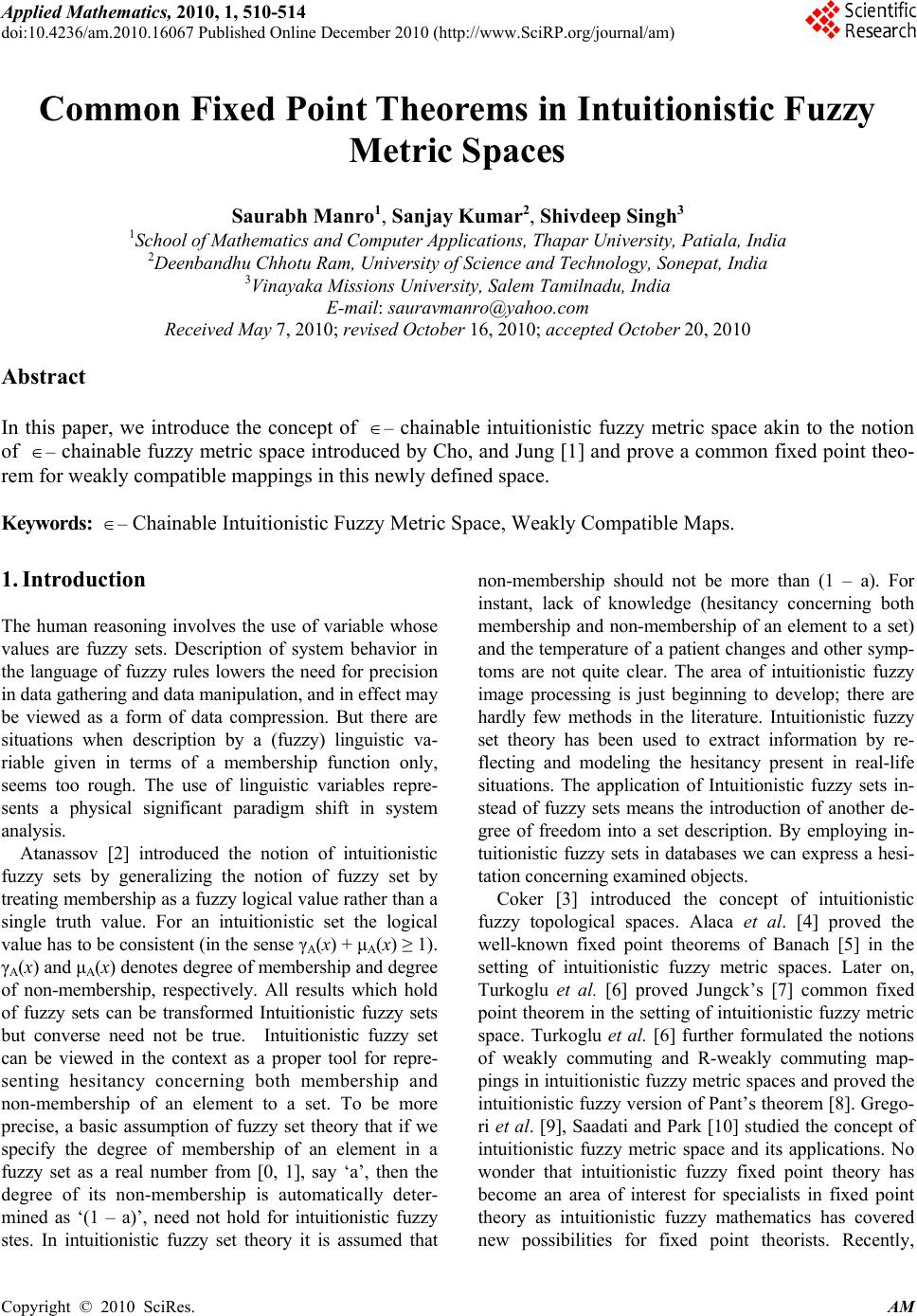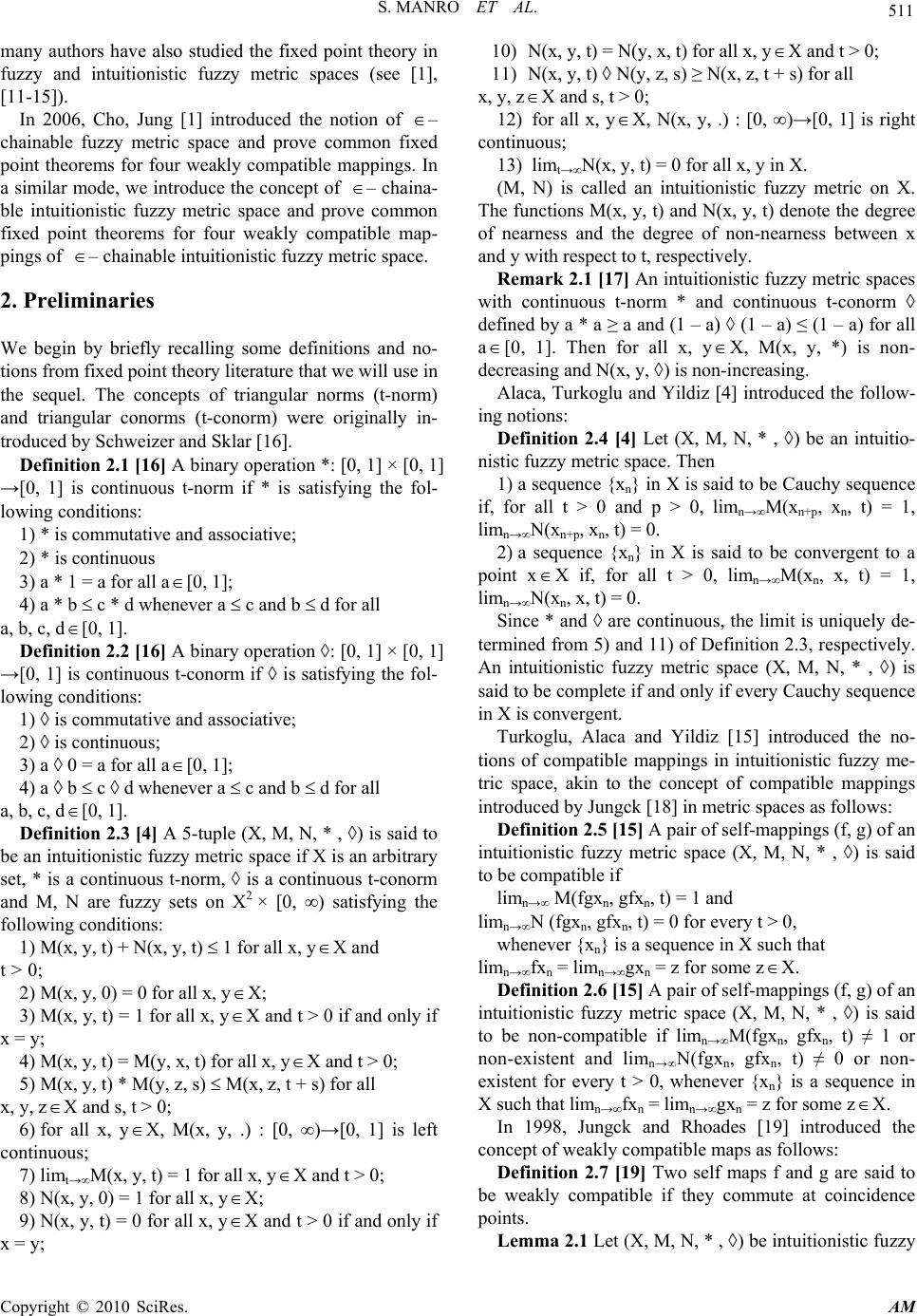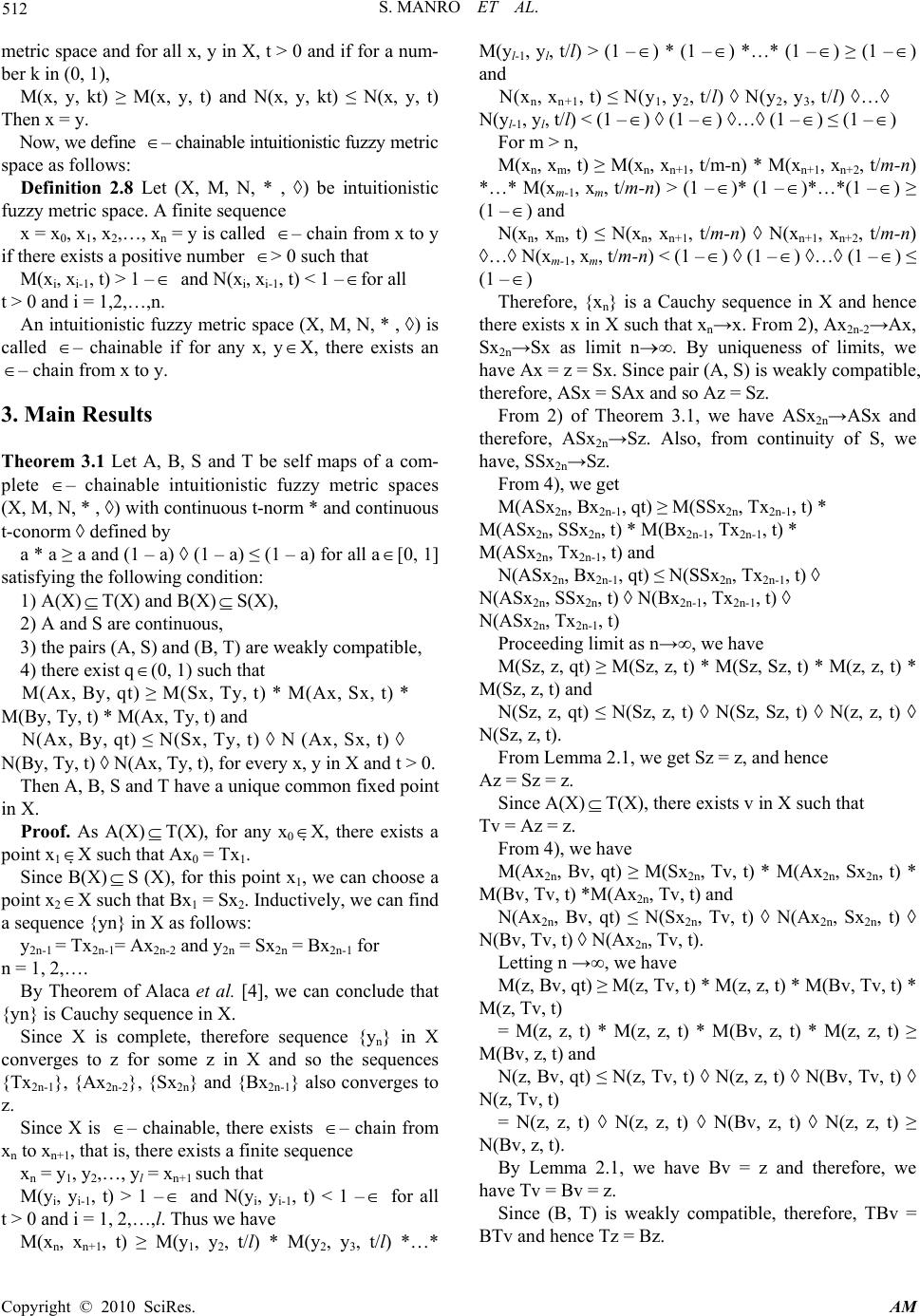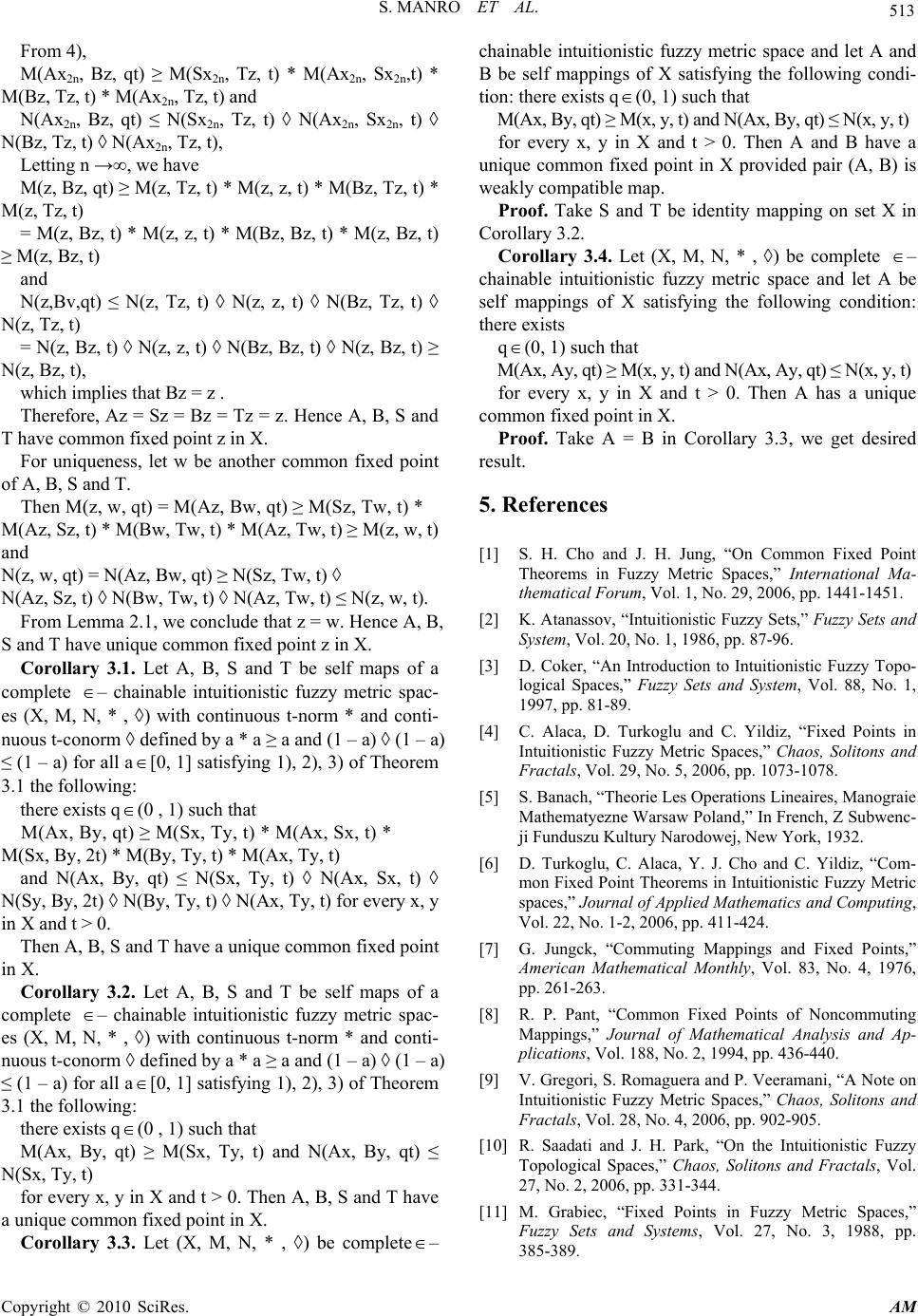Paper Menu >>
Journal Menu >>
 Applied Mathematics, 2010, 1, 510-514 doi:10.4236/am.2010.16067 Published Online December 2010 (http://www.SciRP.org/journal/am) Copyright © 2010 SciRes. AM Common Fixed Point Theorems in Intuitionistic Fuzzy Metric Spaces Saurabh Manro1, Sanjay Kumar2, Shivdeep Singh3 1School of Mathematics and Computer Applications, Thapar University, Patiala, India 2Deenbandhu Chhotu Ram , University of Science and Technology, Sonepat, India 3Vinayaka Missions University, Salem Tamilnadu, India E-mail: sauravmanro@yahoo.com Received May 7, 2010; revised October 16, 2010; accepted October 20, 2010 Abstract In this paper, we introduce the concept of – chainable intuitionistic fuzzy metric space akin to the notion of – chainable fuzzy metric space introduced by Cho, and Jung [1] and prove a common fixed point theo- rem for weakly compatible mappings in this newly defined space. Keywords: – Chainable Intuitionistic Fuzzy Metric Space, Weakly Compatible Maps. 1. Introduction The human reasoning involves the use of variable whose values are fuzzy sets. Description of system behavior in the language of fuzzy rules lowers the need for precision in data gathering and data manipulation, and in effect may be viewed as a form of data compression. But there are situations when description by a (fuzzy) linguistic va- riable given in terms of a membership function only, seems too rough. The use of linguistic variables repre- sents a physical significant paradigm shift in system analysis. Atanassov [2] introduced the notion of intuitionistic fuzzy sets by generalizing the notion of fuzzy set by treating membership as a fuzzy logical value rather than a single truth value. For an intuitionistic set the logical value has to be consistent (in the sense γA(x) + μA(x) ≥ 1). γA(x) and μA(x) denotes degree of membership and degree of non-membership, respectively. All results which hold of fuzzy sets can be transformed Intuitionistic fuzzy sets but converse need not be true. Intuitionistic fuzzy set can be viewed in the context as a proper tool for repre- senting hesitancy concerning both membership and non-membership of an element to a set. To be more precise, a basic assumption of fuzzy set theory that if we specify the degree of membership of an element in a fuzzy set as a real number from [0, 1], say ‘a’, then the degree of its non-membership is automatically deter- mined as ‘(1 – a)’, need not hold for intuitionistic fuzzy stes. In intuitionistic fuzzy set theory it is assumed that non-membership should not be more than (1 – a). For instant, lack of knowledge (hesitancy concerning both membership and non-membership of an element to a set) and the temperature of a patient changes and other symp- toms are not quite clear. The area of intuitionistic fuzzy image processing is just beginning to develop; there are hardly few methods in the literature. Intuitionistic fuzzy set theory has been used to extract information by re- flecting and modeling the hesitancy present in real-life situations. The application of Intuitionistic fuzzy sets in- stead of fuzzy sets means the introduction of another de- gree of freedom into a set description. By employing in- tuitionistic fuzzy sets in databases we can express a hesi- tation concerning examined objects. Coker [3] introduced the concept of intuitionistic fuzzy topological spaces. Alaca et al. [4] proved the well-known fixed point theorems of Banach [5] in the setting of intuitionistic fuzzy metric spaces. Later on, Turkoglu et al. [6] proved Jungck’s [7] common fixed point theorem in the setting of intuitionistic fuzzy metric space. Turkoglu et al. [6] further formulated the notions of weakly commuting and R-weakly commuting map- pings in intuitionistic fuzzy metric spaces and proved the intuitionistic fuzzy version of Pant’s theorem [8]. Grego- ri et al. [9], Saadati and Park [10] studied the concept of intuitionistic fuzzy metric space and its applications. No wonder that intuitionistic fuzzy fixed point theory has become an area of interest for specialists in fixed point theory as intuitionistic fuzzy mathematics has covered new possibilities for fixed point theorists. Recently,  S. MANRO ET AL. Copyright © 2010 SciRes. AM 511 many authors have also studied the fixed point theory in fuzzy and intuitionistic fuzzy metric spaces (see [1], [11-15]). In 2006, Cho, Jung [1] introduced the notion of – chainable fuzzy metric space and prove common fixed point theorems for four weakly compatible mappings. In a similar mode, we introduce the concept of – chaina- ble intuitionistic fuzzy metric space and prove common fixed point theorems for four weakly compatible map- pings of – chainable intuitionistic fuzzy metric space. 2. Preliminaries We begin by briefly recalling some definitions and no- tions from fixed point theory literature that we will use in the sequel. The concepts of triangular norms (t-norm) and triangular conorms (t-conorm) were originally in- troduced by Schweizer and Sklar [16]. Definition 2.1 [16] A binary operation *: [0, 1] × [0, 1] →[0, 1] is continuous t-norm if * is satisfying the fol- lowing conditions: 1) * is commutative and associative; 2) * is continuous 3) a * 1 = a for all a[0, 1]; 4) a * b c * d whenever a c and b d for all a, b, c, d[0, 1]. Definition 2.2 [16] A binary operation ◊: [0, 1] × [0, 1] →[0, 1] is continuous t-conorm if ◊ is satisfying the fol- lowing conditions: 1) ◊ is commutative and associative; 2) ◊ is continuous; 3) a ◊ 0 = a for all a[0, 1]; 4) a ◊ b c ◊ d whenever a c and b d for all a, b, c, d[0, 1]. Definition 2.3 [4] A 5-tuple (X, M, N, * , ◊) is said to be an intuitionistic fuzzy metric space if X is an arbitrary set, * is a continuous t-norm, ◊ is a continuous t-conorm and M, N are fuzzy sets on X2 × [0, ∞) satisfying the following conditions: 1) M(x, y, t) + N(x, y, t) 1 for all x, yX and t > 0; 2) M(x, y, 0) = 0 for all x, y X; 3) M(x, y, t) = 1 for all x, y X and t > 0 if and only if x = y; 4) M(x, y, t) = M(y, x, t) for all x, yX and t > 0; 5) M(x, y, t) * M(y, z, s) M(x, z, t + s) for all x, y, zX and s, t > 0; 6) for all x, yX, M(x, y, .) : [0, ∞)→[0, 1] is left continuous; 7) limt→∞M(x, y, t) = 1 for all x, yX and t > 0; 8) N(x, y, 0) = 1 for all x, y X; 9) N(x, y, t) = 0 for all x, y X and t > 0 if and only if x = y; 10) N(x, y, t) = N(y, x, t) for all x, yX and t > 0; 11) N(x, y, t) ◊ N(y, z, s) ≥ N(x, z, t + s) for all x, y, z X and s, t > 0; 12) for all x, y X, N(x, y, .) : [0, ∞)→[0, 1] is right continuous; 13) limt→∞N(x, y, t) = 0 for all x, y in X. (M, N) is called an intuitionistic fuzzy metric on X. The functions M(x, y, t) and N(x, y, t) denote the degree of nearness and the degree of non-nearness between x and y with respect to t, respectively. Remark 2.1 [17] An intuitionistic fuzzy metric spaces with continuous t-norm * and continuous t-conorm ◊ defined by a * a ≥ a and (1 – a) ◊ (1 – a) ≤ (1 – a) for all a [0, 1]. Then for all x, yX, M(x, y, *) is non- decreasing and N(x, y, ◊) is non-increasing. Alaca, Turkoglu and Yildiz [4] introduced the follow- ing notions: Definition 2.4 [4] Let (X, M, N, * , ◊) be an intuitio- nistic fuzzy metric space. Then 1) a sequence {xn} in X is said to be Cauchy sequence if, for all t > 0 and p > 0, limn→∞M(xn+p, xn, t) = 1, limn→∞N(xn+p, xn, t) = 0. 2) a sequence {xn} in X is said to be convergent to a point x X if, for all t > 0, limn→∞M(xn, x, t) = 1, limn→∞N(xn, x, t) = 0. Since * and ◊ are continuous, the limit is uniquely de- termined from 5) and 11) of Definition 2.3, respectively. An intuitionistic fuzzy metric space (X, M, N, * , ◊) is said to be complete if and only if every Cauchy sequence in X is convergent. Turkoglu, Alaca and Yildiz [15] introduced the no- tions of compatible mappings in intuitionistic fuzzy me- tric space, akin to the concept of compatible mappings introduced by Jungck [18] in metric spaces as follows: Definition 2.5 [15] A pair of self-mappings (f, g) of an intuitionistic fuzzy metric space (X, M, N, * , ◊) is said to be compatible if limn→∞ M(fgxn, gfxn, t) = 1 and limn→∞N (fgxn, gfxn, t) = 0 for every t > 0, whenever {xn} is a sequence in X such that limn→∞fxn = limn→∞gxn = z for some zX. Definition 2.6 [15] A pair of self-mappings (f, g) of an intuitionistic fuzzy metric space (X, M, N, * , ◊) is said to be non-compatible if limn→∞M(fgxn, gfxn, t) ≠ 1 or non-existent and limn→∞N(fgxn, gfxn, t) ≠ 0 or non- existent for every t > 0, whenever {xn} is a sequence in X such that limn→∞fxn = limn→∞gxn = z for some z X. In 1998, Jungck and Rhoades [19] introduced the concept of weakly compatible maps as follows: Definition 2.7 [19] Two self maps f and g are said to be weakly compatible if they commute at coincidence points. Lemma 2.1 Let (X, M, N, * , ◊) be intuitionistic fuzzy  S. MANRO ET AL. Copyright © 2010 SciRes. AM 512 metric space and for all x, y in X, t > 0 and if for a num- ber k in (0, 1), M(x, y, kt) ≥ M(x, y, t) and N(x, y, kt) ≤ N(x, y, t) Then x = y. Now, we define – chainable intuitionistic fuzzy metric space as follows: Definition 2.8 Let (X, M, N, * , ◊) be intuitionistic fuzzy metric space. A finite sequence x = x0, x1, x2,…, xn = y is called – chain from x to y if there exists a positive number > 0 such that M(xi, xi-1, t) > 1 – and N(xi, xi-1, t) < 1 –for all t > 0 and i = 1,2,…,n. An intuitionistic fuzzy metric space (X, M, N, * , ◊) is called – chainable if for any x, yX, there exists an – chain from x to y. 3. Main Results Theorem 3.1 Let A, B, S and T be self maps of a com- plete – chainable intuitionistic fuzzy metric spaces (X, M, N, * , ◊) with continuous t-norm * and continuous t-conorm ◊ defined by a * a ≥ a and (1 – a) ◊ (1 – a) ≤ (1 – a) for all a [0, 1] satisfying the following condition: 1) A(X) T(X) and B(X)S(X), 2) A and S are continuous, 3) the pairs (A, S) and (B, T) are weakly compatible, 4) there exist q(0, 1) such that M(Ax, By, qt) ≥ M(Sx, Ty, t) * M(Ax, Sx, t) * M(By, Ty, t) * M(Ax, Ty, t) and N(Ax, By, qt) ≤ N(Sx, Ty, t) ◊ N (Ax, Sx, t) ◊ N(By, Ty, t) ◊ N(Ax, Ty, t), for every x, y in X and t > 0. Then A, B, S and T have a unique common fixed point in X. Proof. As A(X)T(X), for any x0X, there exists a point x1X such that Ax0 = Tx1. Since B(X)S (X), for this point x1, we can choose a point x2X such that Bx1 = Sx2. Inductively, we can find a sequence {yn} in X as follows: y2n-1 = Tx2n-1= Ax2n-2 and y2n = Sx2n = Bx2n-1 for n = 1, 2,…. By Theorem of Alaca et al. [4], we can conclude that {yn} is Cauchy sequence in X. Since X is complete, therefore sequence {yn} in X converges to z for some z in X and so the sequences {Tx2n-1}, {Ax2n-2}, {Sx2n} and {Bx2n-1} also converges to z. Since X is – chainable, there exists – chain from xn to xn+1, that is, there exists a finite sequence xn = y1, y2,…, yl = xn+1 such that M(yi, yi-1, t) > 1 – and N(yi, yi-1, t) < 1 – for all t > 0 and i = 1, 2,…,l. Thus we have M(xn, xn+1, t) ≥ M(y1, y2, t/l) * M(y2, y3, t/l) *…* M(yl-1, yl, t/l) > (1 – ) * (1 –) *…* (1 –) ≥ (1 – ) and N(xn, xn+1, t) ≤ N(y1, y2, t/l) ◊ N(y2, y3, t/l) ◊…◊ N(yl-1, yl, t/l) < (1 – ) ◊ (1 –) ◊…◊ (1 –) ≤ (1 – ) For m > n, M(xn, xm, t) ≥ M(xn, xn+1, t/m-n) * M(xn+1, xn+2, t/m-n) *…* M(xm-1, xm, t/m-n) > (1 –)* (1 –)*…*(1 – ) ≥ (1 – ) and N(xn, xm, t) ≤ N(xn, xn+1, t/m-n) ◊ N(xn+1, xn+2, t/m-n) ◊…◊ N(xm-1, xm, t/m-n) < (1 –) ◊ (1 –) ◊…◊ (1 – ) ≤ (1 – ) Therefore, {xn} is a Cauchy sequence in X and hence there exists x in X such that xn→x. From 2), Ax2n-2→Ax, Sx2n→Sx as limit n∞. By uniqueness of limits, we have Ax = z = Sx. Since pair (A, S) is weakly compatible, therefore, ASx = SAx and so Az = Sz. From 2) of Theorem 3.1, we have ASx2n→ASx and therefore, ASx2n→Sz. Also, from continuity of S, we have, SSx2n→Sz. From 4), we get M(ASx2n, Bx2n-1, qt) ≥ M(SSx2n, Tx2n-1, t) * M(ASx2n, SSx2n, t) * M(Bx2n-1, Tx2n-1, t) * M(ASx2n, Tx2n-1, t) and N(ASx2n, Bx2n-1, qt) ≤ N(SSx2n, Tx2n-1, t) ◊ N(ASx2n, SSx2n, t) ◊ N(Bx2n-1, Tx2n-1, t) ◊ N(ASx2n, Tx2n-1, t) Proceeding limit as n→∞, we have M(Sz, z, qt) ≥ M(Sz, z, t) * M(Sz, Sz, t) * M(z, z, t) * M(Sz, z, t) and N(Sz, z, qt) ≤ N(Sz, z, t) ◊ N(Sz, Sz, t) ◊ N(z, z, t) ◊ N(Sz, z, t). From Lemma 2.1, we get Sz = z, and hence Az = Sz = z. Since A(X)T(X), there exists v in X such that Tv = Az = z. From 4), we have M(Ax2n, Bv, qt) ≥ M(Sx2n, Tv, t) * M(Ax2n, Sx2n, t) * M(Bv, Tv, t) *M(Ax2n, Tv, t) and N(Ax2n, Bv, qt) ≤ N(Sx2n, Tv, t) ◊ N(Ax2n, Sx2n, t) ◊ N(Bv, Tv, t) ◊ N(Ax2n, Tv, t). Letting n →∞, we have M(z, Bv, qt) ≥ M(z, Tv, t) * M(z, z, t) * M(Bv, Tv, t) * M(z, Tv, t) = M(z, z, t) * M(z, z, t) * M(Bv, z, t) * M(z, z, t) ≥ M(Bv, z, t) and N(z, Bv, qt) ≤ N(z, Tv, t) ◊ N(z, z, t) ◊ N(Bv, Tv, t) ◊ N(z, Tv, t) = N(z, z, t) ◊ N(z, z, t) ◊ N(Bv, z, t) ◊ N(z, z, t) ≥ N(Bv, z, t). By Lemma 2.1, we have Bv = z and therefore, we have Tv = Bv = z. Since (B, T) is weakly compatible, therefore, TBv = BTv and hence Tz = Bz.  S. MANRO ET AL. Copyright © 2010 SciRes. AM 513 From 4), M(Ax2n, Bz, qt) ≥ M(Sx2n, Tz, t) * M(Ax2n, Sx2n,t) * M(Bz, Tz, t) * M(Ax2n, Tz, t) and N(Ax2n, Bz, qt) ≤ N(Sx2n, Tz, t) ◊ N(Ax2n, Sx2n, t) ◊ N(Bz, Tz, t) ◊ N(Ax2n, Tz, t), Letting n →∞, we have M(z, Bz, qt) ≥ M(z, Tz, t) * M(z, z, t) * M(Bz, Tz, t) * M(z, Tz, t) = M(z, Bz, t) * M(z, z, t) * M(Bz, Bz, t) * M(z, Bz, t) ≥ M(z, Bz, t) and N(z,Bv,qt) ≤ N(z, Tz, t) ◊ N(z, z, t) ◊ N(Bz, Tz, t) ◊ N(z, Tz, t) = N(z, Bz, t) ◊ N(z, z, t) ◊ N(Bz, Bz, t) ◊ N(z, Bz, t) ≥ N(z, Bz, t), which implies that Bz = z . Therefore, Az = Sz = Bz = Tz = z. Hence A, B, S and T have common fixed point z in X. For uniqueness, let w be another common fixed point of A, B, S and T. Then M(z, w, qt) = M(Az, Bw, qt) ≥ M(Sz, Tw, t) * M(Az, Sz, t) * M(Bw, Tw, t) * M(Az, Tw, t) ≥ M(z, w, t) and N(z, w, qt) = N(Az, Bw, qt) ≥ N(Sz, Tw, t) ◊ N(Az, Sz, t) ◊ N(Bw, Tw, t) ◊ N(Az, Tw, t) ≤ N(z, w, t). From Lemma 2.1, we conclude that z = w. Hence A, B, S and T have unique common fixed point z in X. Corollary 3.1. Let A, B, S and T be self maps of a complete – chainable intuitionistic fuzzy metric spac- es (X, M, N, * , ◊) with continuous t-norm * and conti- nuous t-conorm ◊ defined by a * a ≥ a and (1 – a) ◊ (1 – a) ≤ (1 – a) for all a[0, 1] satisfying 1), 2), 3) of Theorem 3.1 the following: there exists q(0 , 1) such that M(Ax, By, qt) ≥ M(Sx, Ty, t) * M(Ax, Sx, t) * M(Sx, By, 2t) * M(By, Ty, t) * M(Ax, Ty, t) and N(Ax, By, qt) ≤ N(Sx, Ty, t) ◊ N(Ax, Sx, t) ◊ N(Sy, By, 2t) ◊ N(By, Ty, t) ◊ N(Ax, Ty, t) for every x, y in X and t > 0. Then A, B, S and T have a unique common fixed point in X. Corollary 3.2. Let A, B, S and T be self maps of a complete – chainable intuitionistic fuzzy metric spac- es (X, M, N, * , ◊) with continuous t-norm * and conti- nuous t-conorm ◊ defined by a * a ≥ a and (1 – a) ◊ (1 – a) ≤ (1 – a) for all a[0, 1] satisfying 1), 2), 3) of Theorem 3.1 the following: there exists q(0 , 1) such that M(Ax, By, qt) ≥ M(Sx, Ty, t) and N(Ax, By, qt) ≤ N(Sx, Ty, t) for every x, y in X and t > 0. Then A, B, S and T have a unique common fixed point in X. Corollary 3.3. Let (X, M, N, * , ◊) be complete – chainable intuitionistic fuzzy metric space and let A and B be self mappings of X satisfying the following condi- tion: there exists q (0, 1) such that M(Ax, By, qt) ≥ M(x, y, t) and N(Ax, By, qt) ≤ N(x, y, t) for every x, y in X and t > 0. Then A and B have a unique common fixed point in X provided pair (A, B) is weakly compatible map. Proof. Take S and T be identity mapping on set X in Corollary 3.2. Corollary 3.4. Let (X, M, N, * , ◊) be complete – chainable intuitionistic fuzzy metric space and let A be self mappings of X satisfying the following condition: there exists q (0, 1) such that M(Ax, Ay, qt) ≥ M(x, y, t) and N(Ax, Ay, qt) ≤ N(x, y, t) for every x, y in X and t > 0. Then A has a unique common fixed point in X. Proof. Take A = B in Corollary 3.3, we get desired result. 5. References [1] S. H. Cho and J. H. Jung, “On Common Fixed Point Theorems in Fuzzy Metric Spaces,” International Ma- thematical Forum, Vol. 1, No. 29, 2006, pp. 1441-1451. [2] K. Atanassov, “Intuitionistic Fuzzy Sets,” Fuzzy Sets and System, Vol. 20, No. 1, 1986, pp. 87-96. [3] D. Coker, “An Introduction to Intuitionistic Fuzzy Topo- logical Spaces,” Fuzzy Sets and System, Vol. 88, No. 1, 1997, pp. 81-89. [4] C. Alaca, D. Turkoglu and C. Yildiz, “Fixed Points in Intuitionistic Fuzzy Metric Spaces,” Chaos, Solitons and Fractals, Vol. 29, No. 5, 2006, pp. 1073-1078. [5] S. Banach, “Theorie Les Operations Lineaires, Manograie Mathematyezne Warsaw Poland,” In French, Z Subwenc- ji Funduszu Kultury Narodowej, New York, 1932. [6] D. Turkoglu, C. Alaca, Y. J. Cho and C. Yildiz, “Com- mon Fixed Point Theorems in Intuitionistic Fuzzy Metric spaces,” Journal of Applied Mathematics and Computing, Vol. 22, No. 1-2, 2006, pp. 411-424. [7] G. Jungck, “Commuting Mappings and Fixed Points,” American Mathematical Monthly, Vol. 83, No. 4, 1976, pp. 261-263. [8] R. P. Pant, “Common Fixed Points of Noncommuting Mappings,” Journal of Mathematical Analysis and Ap- plications, Vol. 188, No. 2, 1994, pp. 436-440. [9] V. Gregori, S. Romaguera and P. Veeramani, “A Note on Intuitionistic Fuzzy Metric Spaces,” Chaos, Solitons and Fractals, Vol. 28, No. 4, 2006, pp. 902-905. [10] R. Saadati and J. H. Park, “On the Intuitionistic Fuzzy Topological Spaces,” Chaos, Solitons and Fractals, Vol. 27, No. 2, 2006, pp. 331-344. [11] M. Grabiec, “Fixed Points in Fuzzy Metric Spaces,” Fuzzy Sets and Systems, Vol. 27, No. 3, 1988, pp. 385-389.  S. MANRO ET AL. Copyright © 2010 SciRes. AM 514 [12] M. Imdad and Javid Ali, “Some Common Fixed Point Theorems in Fuzzy Metric Spaces,” Mathematical Com- munication, Vol. 11, No. 12, 2006, pp. 153-163. [13] J. H. Park, “Intuitionistic Fuzzy Metric Spaces,” Chaos, Solitons & Fractals, Vol. 22, No. 52004, pp. 1039-1046. [14] J. S. Park, Y. C. Kwun and J. H. Park, “A Fixed Point Theorem in the Intuitionistic Fuzzy Metric Spaces,” Far East Journal of Mathematical Sciences, Vol. 16, No. 2, 2005, pp. 137-149. [15] D. Turkoglu, C. Alaca and C. Yildiz, “Compatible Maps and Compatible Maps of Types (α) and (β) in Intuitionis- tic Fuzzy Metric Spaces,” Demonstration Mathematica, Vol. 39, No. 3, 2006, pp. 671-684. [16] B. Schweizer and A. Sklar, “Statistical Metric Spaces,” Pacific Journal Mathematic, Vol. 10, 1960, pp. 314-334. [17] C. Alaca, I. Altun and D. Turkoglu, “On Compatible Mappings of Type (I) and Type (II) in Intuitionistic Fuzzy Metric Spaces,” Korean Mathematical Society, Vol. 23, No. 3, 2008, pp. 427-446. [18] G. Jungck, “Compatible Mappings and Common Fixed Points,” International Journal of Mathematics and Ma- thematical Sciences, Vol. 9, No. 4, 1986, pp. 771-779. [19] G. Jungck and B. E. Rhoades, “Fixed Point for Set Va- lued Functions without Continuity,” Indian Journal of Pure and Applied Mathematics, Vol. 29, No. 3, 1998, pp. 227-238. |

